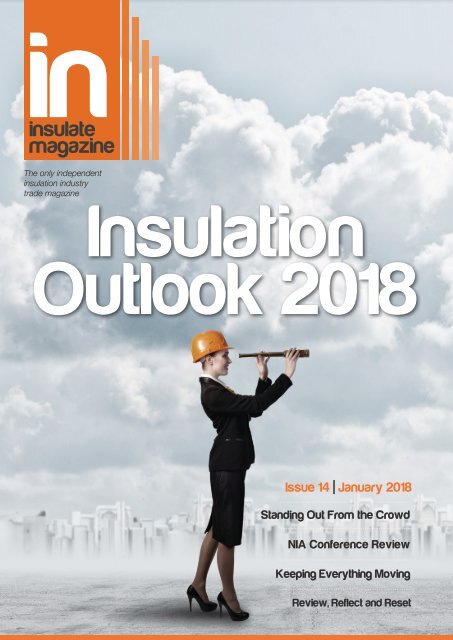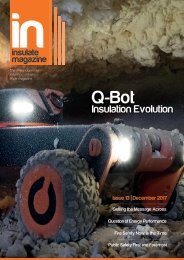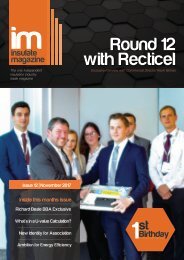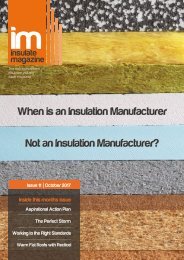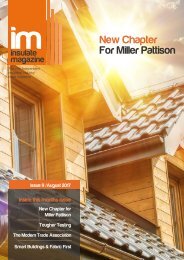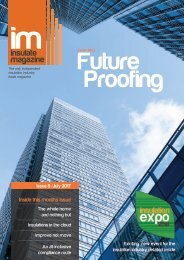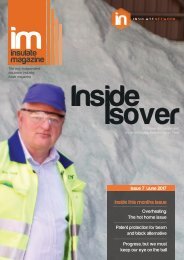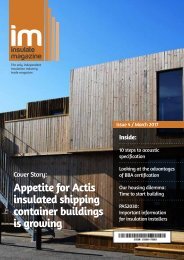Insulate Magazine Issue 14
You also want an ePaper? Increase the reach of your titles
YUMPU automatically turns print PDFs into web optimized ePapers that Google loves.
The only independent<br />
insulation industry<br />
trade magazine<br />
Insulation<br />
Outlook 2018<br />
<strong>Issue</strong> <strong>14</strong> | January 2018<br />
Standing Out From the Crowd<br />
NIA Conference Review<br />
Keeping Everything Moving<br />
Review, Reflect and Reset
NOW AVAILABLE<br />
WWW.INSULATENETWORK.COM | SALES@INSULATENETWORK.COM | 01948 759 351
Published on a monthly basis by Versanta ltd<br />
Corser House, 17 Geen End, Whitchurch, Shropshire, SY13 1AD<br />
Call 01948 759 351<br />
Outside of the UK +44 1948 759351<br />
Monday - Friday 9am - 5.30pm<br />
Website: www.insulatenetwork.com<br />
Email: sales@insulatenetwork.com<br />
Insulation Outlook 2018<br />
www.insulatenetwork.com<br />
Contents<br />
6-8<br />
SUBSCRIPTION INFORMATION<br />
Anyone can subscribe for free online at https://insulatenetwork.<br />
com/insulate-magazine-free-subscription<br />
Subscriptions are available around the world free in digital format.<br />
Print subscriptions are available around the world, please call us for<br />
a quote or email us on sales@insulatenetwork.com<br />
Our subscriber list is occasionally made available to very carefully<br />
selected companies whose products or services may be of interest<br />
to you. Your privacy is of paramount importance to us and should<br />
you prefer not to be part of these lists then please email your details<br />
and a short message to sales@insulatenetwork.com<br />
CLASSIFIED ADVERTISING<br />
Rate: No photo classified £25 for 20 words, each additional word<br />
costs £1. All classified advertising must be paid in advance. We<br />
must receive your classified advert at least two weeks prior to the<br />
publication date.<br />
NIA Conference Review 2017 10-13<br />
BBA Leads the Way<br />
<strong>14</strong>-15<br />
Standing Out from the Crowd 16-19<br />
A Call to Action 20<br />
WE DO NOT ACCEPT PHONE IN CLASSIFIED ADVERTISING<br />
In the first instance, email your advert to sales@insulatenetwork.<br />
com and await your invoice, once payment is received our design<br />
team will clarify the advert insertion with you directly. CLASSIFIED<br />
ADVERTISING APPEARS IN PRINT AND ONLINE. WE ARE NOT<br />
RESPONSIBLE FOR ERRORS AFTER PROOFING AND INSER-<br />
TION.<br />
DISPLAY ADVERTISING.<br />
Contact one of our sales staff to discuss your requirements on<br />
01948 759 351. Publisher reserves the right to reject any<br />
advertising that in its opinion is misleading, unfair or incompatible<br />
with the character of the magazine.<br />
We adhere to the IPSO code of practice for editors. Further information<br />
can be found at www.ipso.org.uk<br />
BACK ISSUES OR REPRINTS<br />
Digital back issues can be foud online at www.insulatenetworkazine.com<br />
For printed editions please email contact@insulatenetwork.com<br />
, there will be a postage charge and handling fee of<br />
£5+VAT for each copy requested.<br />
CIRCULATION<br />
The magazine is sent to 17,000 digitial subscribers per month<br />
Improve and Respond to the Challenges 21<br />
Hearing Protection : Communication 22-23<br />
Review Reflect and Reset<br />
24-25<br />
Keeping Everything Moving 26-29<br />
ASFP Endorses Independent Review<br />
31<br />
Decarbonisation and Building Regulations 32<br />
©VERSANTA LTD<br />
No part can be reproduced without the express<br />
permission of the publisher<br />
www.instagram.com/insulatenetwork<br />
www.twitter.com/insulatenetwork<br />
www.youtube.com/channel/insulatenetwork<br />
The UK's only dedicated<br />
trade journal for the insulation industry<br />
3
Happy New Year! As we begin 2018, having reflected on what<br />
has been a turbulent 12 months for the Insulation Industry, the<br />
focus here at <strong>Insulate</strong> Network has become one of unity and<br />
communication.<br />
Interviews with key industry leaders have revealed a common theme of<br />
continued focus on customer needs and assurances through testing and<br />
products being “fit for purpose” along with continued Brexit uncertainty.<br />
Colin Heath<br />
Managing Editor<br />
colin@insulatenetwork.com<br />
@colinversanta<br />
Also in this issue, our newly appointed Technical Editor, Paul Forrester looks<br />
at the specification and design of insulation systems and the industry supply<br />
chain in his feature “keeping Everything moving”<br />
As always, pages are full to the brim with information – perfect for keeping<br />
up to date with the latest news from across the industry, contributions from<br />
MIMA and a full round up of last months National Insulation Association conference<br />
where a fresh approach to collaboration was a key theme.<br />
I hope you enjoy this issue.<br />
Colin<br />
Jamie Street<br />
Head of Creative<br />
jamie@insulatenetwork.com<br />
@jamieversanta<br />
4<br />
www.insulatenetwork.com
ecobuild<br />
The future of the built environment is here<br />
06-08 March 2018 / ExCeL, London<br />
Timber<br />
Concrete<br />
Infrastructure<br />
Green & Blue<br />
Infrastructure<br />
Offsite<br />
Energy & HVAC<br />
Building<br />
Performance<br />
District Energy<br />
Presenting the futurebuild districts<br />
The ‘must go’ event<br />
in the construction<br />
industry calendar<br />
for forward thinking<br />
professionals and<br />
influencers.<br />
ecobuild 2018 will<br />
present the latest<br />
technology, the freshest<br />
thinking and materials<br />
to keep you at the<br />
forefront of the industry.<br />
The centrepiece will<br />
be the comprehensive<br />
conference programme<br />
curated by top industry<br />
fi gures. Surrounding<br />
this will be a series of<br />
futurebuild districts, each<br />
exploring a di erent<br />
aspect of the built<br />
environment.<br />
Be part of<br />
something<br />
special<br />
+44 (0)20 3011 2540<br />
info@ecobuild.co.uk<br />
www.ecobuild.co.uk<br />
#ecobuild<br />
#ecobuild<br />
/ecobuildnow<br />
/ecobuildnow<br />
/ecobuild_now<br />
ecobuild-uk<br />
SUPPORTED BY
Cover Feature Exclusive<br />
Insulation<br />
Outlook 2018<br />
As we enter 2018, what better time to sit down<br />
and speak to some of the insulation industry<br />
leading voices to get their view on the events<br />
of 2017 and to take a look at what challenges and<br />
opportunities they expect from the year ahead?<br />
Colin Heath, Managing Editor at <strong>Insulate</strong> <strong>Magazine</strong><br />
exclusively spoke to Ann Fisher, Brand Director at SIG,<br />
David Travill, Managing Director at Saint-Gobain Isover and<br />
Trevor Horsely, the Chief Executive Office of Western<br />
Thermal Ltd. Keep Reading...<br />
6
The only independent insulation industry trade magazine<br />
An Inside Look<br />
at Insulation in 2018<br />
In a few words, how do you see the outlook for the insulation industry in 2018?<br />
The insulation market will be resilient in 2018 as a sector influenced by current building<br />
regulations yet to be fully implemented by housebuilders, demand for acoustic solutions<br />
remaining high in the commercial interiors market, and increased RMI work on facades<br />
and cladding projects. However there will be challenges as manufacturing capacity,<br />
continental European market demands and upstream supply pressures will continue to<br />
impact in 2018 as we have experienced over the last few months.<br />
Do you see any<br />
changes occurring in<br />
the next 12 months, if<br />
so, what might they<br />
be?<br />
There will be increased demands<br />
from customers for specified tested products and<br />
evidence on compliance of supply and traceability, as an<br />
industry we need to ensure we can support customers<br />
with that assurance.<br />
And what excites you?<br />
Taking the market information, supplier and<br />
customer feedback and bringing that together to deliver<br />
an SIG Distribution Brand and Sales strategy to ensure<br />
the Insulation range of products, suppliers and solutions<br />
we offer is what the customers and market requires<br />
therefore enabling SIG Distribution to continue to lead the<br />
market.<br />
What areas will you be focussing on as a<br />
business in 2018?<br />
SIG will be focussing on listening to the customers and<br />
suppliers to ensure we get the best offer of systems, products<br />
and service into the market.<br />
What was your company’s high point for 2017<br />
The SIG Distribution Diamond Ball was one of the year’s highlights<br />
with 200 customers and suppliers attending the 60th<br />
Anniversary event in London, as part of the event one lucky<br />
customer won a fabulous pair of Diamond earrings his wife<br />
was delighted!!!<br />
What worries you about the year ahead?<br />
There is uncertainty over the impact of Brexit, skills shortages<br />
and some softness in the market forecasts over construction<br />
in the commercial sectors.<br />
Ann Fisher – Brand Director<br />
Insulation & Drylining SIG Distribution<br />
Responsible for the Insulation Sales strategy for<br />
SIG Distribution, experienced in both Insulation<br />
Manufacturing and Distribution, Ann has worked<br />
in the UK and Europe building extensive knowledge<br />
of the requirements of being a valued route<br />
to market for suppliers and customers.<br />
www.insulatenetwork.com<br />
7
The only independent insulation industry trade magazine<br />
In a few words, how do<br />
you see the outlook for<br />
the insulation industry<br />
in 2018?<br />
The outlook is positive in<br />
the H&V sector. Engineering<br />
sector will struggle until<br />
some of the big nuclear<br />
contracts get under way.<br />
Do you see any changes<br />
occurring in the next<br />
12 months, if so, what<br />
might they be?<br />
Changes may occur within the infrastructure sector. I believe<br />
new builds will slow down, and the refurb sector will<br />
gather momentum.<br />
What areas will you be focussing on<br />
as a business in 2018?<br />
Globally on the H&V sector and<br />
following the recent acquisition of Henderson Site Services<br />
we will be expanding further into the<br />
pharmaceutical and food sectors.<br />
What was your company’s high point for 2017<br />
The IGL acquisition and HSS acquisition.<br />
What worries you about the year ahead?<br />
No worries for 2018. Western Thermal have a strong forward<br />
order book. The sector will look for some changes<br />
in 2019 which could be affected by Brexit.<br />
And what excites you?<br />
I get excitement from securing orders, satisfaction, by<br />
supply chain agreements with the clients and the suppliers<br />
and the ongoing development of the company<br />
branches and staff development.<br />
Trevor Horsley founded Western Thermal in 1985<br />
and has guided the company to its current, well<br />
established and profitable position. Has extensive<br />
experience knowledge of the sector and wide contact<br />
base within it. Former President of the Thermal Insulators<br />
Contractors Association (TICA).<br />
In a few words, how do<br />
you see the outlook for<br />
the insulation industry<br />
in 2018?<br />
The underlying drivers remain<br />
strong, especially in<br />
new housing. Hopefully<br />
consumer confidence will<br />
hold up whilst we negotiate<br />
Brexit<br />
Do you see any changes<br />
occurring in the next<br />
12 months, if so, what<br />
might they be?<br />
There will inevitably be a major revision to the building<br />
regulations post Grenfell, and I believe the need to address<br />
the performance gap between theoretic<br />
performance and actual on-site performance may, at<br />
last, gain some momentum.<br />
What areas will you be focussing on as a business<br />
in 2018?<br />
Continue to drive customer engagement and we will<br />
enter some new application/product segments<br />
What was your company’s high point for 2017<br />
Further market share gains, building on progress<br />
delivered in 2015-16.<br />
What worries you about the year ahead?<br />
Losing good people in what is becoming a very competitive<br />
jobs market, input cost inflation, meeting an increased<br />
demand without any compromise in service levels<br />
And what excites you?<br />
Continued focus on customer engagement, further<br />
progress in building a team that has a can-do attitude,<br />
launching some exciting new products, meeting increased<br />
demand without any compromise in service levels<br />
David Travill joined Isover as managing director in<br />
June 2013. With a professional background in the<br />
sales and commercial areas, he has worked in<br />
the construction/building materials sector for almost 30<br />
years. Before joining Isover he held the position of Sales<br />
Director at British Gypsum for 5 years.<br />
8 www.insulatenetwork.com
We’re here to help...<br />
Kiwa UK<br />
BDA<br />
Agrément ®<br />
service<br />
...for roofing, insulation,<br />
waterproofing & façade<br />
construction materials,<br />
products and systems for<br />
the building sector.<br />
BDA Agrément ® is recognised by NHBC and LABC.<br />
The BDA Agrément ® process is designed to underpin<br />
the ‘fitness for purpose’ of products and systems<br />
destined for the UK construction market.<br />
For information please call 01242 677877 or<br />
email bdaenquiries@kiwa.co.uk<br />
Kiwa Ltd.<br />
Unit 5 Prime Park Way,<br />
Prime Enterprise Park,<br />
Derby, DEI 3QB<br />
UK<br />
www.kiwa.co.uk/bda
<strong>Insulate</strong> Exclusive Feature<br />
NIA Annual Conference 2017<br />
Held at the Jurys Inn, Hinckley Island Hotel the Annual Conference of the National<br />
Insulation Association (NIA) convened on 7th December 2017. The key themes of the<br />
conference focussed on collaboration and future planning and <strong>Insulate</strong> Network, Media<br />
Partners for 2017 were there to take part.<br />
10
11
The only independent insulation industry trade magazine<br />
<strong>Insulate</strong> Exclusive<br />
Industry Collaboration and<br />
Future Planning Lead Discussions<br />
Derek Horrocks, Chairman of Sustainable Energy UK<br />
and Permarock Products who was recently appointed<br />
Chair of the NIA opened the conference with a fantastic<br />
address to members, giving a review of 2017, the work<br />
carried out by the Association to support its members<br />
and key achievements and his and the Boards vision for<br />
the future.<br />
The tone for the day was set through commitments<br />
to industry wide collaboration to gain best outcomes,<br />
greater engagement of members, supporting members<br />
and Government by growing the market, tackling climate<br />
change and fuel poverty through insulation. Priority work<br />
streams for the Association included collaborating on<br />
key policy developments, helping its members’ access<br />
business opportunities, improving quality & standards<br />
and confidence in the industry.<br />
potential and win critical bids. The presentation focused<br />
on three key points – the attributes of consistently successful<br />
bids, how your team can recover from a lost bid<br />
and golden rules to deliver repeatable bid success. The<br />
presentation was well received by members.<br />
Malcolm Hanna of the National Energy Foundation gave<br />
a presentation on Internal Wall Insulation opportunities<br />
and a new installation process known as WHISCERS<br />
(Whole House In-Situ Carbon and Energy Reduction<br />
Following on from a members Q&A with the NIA strategic<br />
board the mornings speakers took to the podium,<br />
Denise O’Leary of Purpol Marketing delivered an informative<br />
presentation on bid writing – ‘the winning bid’ she<br />
shared knowledge on how businesses can realise their<br />
Solution) stating that it’s an ideal way of retrofitting internal<br />
wall insulation in hard-to-treat housing.<br />
After lunch NIA Chief Executive, Neil Marshall paid fitting<br />
tribute to outgoing chair, Tony Hardiman MBE, speaking<br />
of Tony’s stewardship of the role, Neil commented<br />
“Tony has committed 16 years to the NIA and was<br />
instrumental in the forming of the organisation and key<br />
achievements; we cannot express enough thanks for his<br />
contribution”.<br />
12<br />
www.insulatenetwork.com
The only independent insulation industry trade magazine<br />
Richard Mellish of the Department for Business, Energy<br />
and Industrial Strategy then delivered a presentation on<br />
future Government policies for energy efficiency and fuel<br />
poverty and said that he looked forward to further input<br />
from the NIA to help shape future policies and programmes.<br />
Colin Timmins of trade association BEAMA delivered a<br />
Summing up Derek Horrocks explained that the aims of<br />
the day were to provide delegates with details of future<br />
opportunities and key information on items that would<br />
impact the industry in 2018. He also urged NIA members<br />
to engage with the NIA team to bring about future<br />
changes that would benefit householders, Government<br />
and the industry. He also thanked the exhibitors and the<br />
sponsors; British Board of Agrement, Kiwa, Energy Store<br />
and AlivaUK for their support in helping fund a successful<br />
event.<br />
presentation on the new industry guidelines for ventilating<br />
a property when insulation is installed which have<br />
been developed jointly by BEAMA and NIA.<br />
The day’s events were concluded with an informative<br />
presentation by Andy Chesterman \Co-Founder and<br />
Data & Compliance Director at DAMM Solutions on the<br />
new General Data Protection Regulations being introduced<br />
in May 2018.<br />
For more information contact Duncan Murray at<br />
the NIA press office on 01604588111 or<br />
email Duncan@provencepr.co.uk<br />
13<br />
13
www.insulatenetwork.com<br />
BBA<br />
Leads<br />
the Way<br />
The UK’s leading certification body provides<br />
comprehensive Audit & Inspection services to<br />
leading companies in the construction industry.<br />
<strong>14</strong><br />
www.insulatenetwork.com
The only independent insulation industry trade magazine<br />
As a recognised mark synonymous with quality products & installations, working with an institution<br />
like the BBA offers considerable benefits to manufacturers. Opportunities to improve business<br />
profiles are particularly sought after in an increasingly competitive market place, where new products<br />
and systems are cropping up all the time.And it’s not just about Increasing sales opportunities. It’s<br />
also about greater efficiency, with a reduction in costs that can lead to more rewards for hard-working staff<br />
and Improved staff motivation. Moreover, working with a USP partner that is a recognised brand is a sign<br />
that manufacturers are committed to raising and maintaining standards for their customers, resulting in an<br />
improved profile among both existing and potential clients.<br />
UKAS accredited and fully independent, BBA Audit &<br />
Inspection has over 50 years’ experience providing first<br />
class inspection & auditing services to organisations<br />
who are committed to maintaining the quality of<br />
products and installations to meet industry<br />
standards. The BBA business unit works in two main<br />
areas: construction products (factory and installation)<br />
carries out over 6000 inspections per year within the<br />
UK, while quality management systems carryies out over<br />
2000 visits per year in over 50 countries worldwide. On<br />
the construction side, inspections cover the BBA’s own<br />
Competent Installer Scheme to supporting client<br />
initiatives and regulation schemes such as PAS<br />
2030:2017. Products covered range from energy<br />
technical monitoring and insulation to high friction<br />
services. On the management systems side, the<br />
BBA offers the main three standards: ISO9001:2015,<br />
<strong>14</strong>001:2015, 18001:2017 with EN1090 being high in<br />
number.<br />
Given the constant changes in regulations, BBA Audit &<br />
Inspection clearly plays a significant part in raising and<br />
maintaining standards across a variety of industries, to<br />
the benefit of clients, the industries they work in and ultimately<br />
the consumer.<br />
Moreover, at a time when a number of issues are coming<br />
to light as a result of badly performed or ill-advised insulation<br />
retrofits, these services are even more welcomed,<br />
not only by home dwellers and property owners, but in\<br />
particular social housing organisations whose responsibilities<br />
are to look after housing stock, usually with limited<br />
budget constraints.<br />
It has perhaps never been more appropriate for organisations<br />
like the BBA to continue to dedicate time and<br />
resource to drive up standards, ensuring the quality<br />
and safety of products and workmanship in the construction<br />
industry, for the ultimate benefit of all our built<br />
surroundings, at work and at home, and all who inhabit<br />
them.<br />
www.insulatenetwork.com<br />
15
Exclusive <strong>Insulate</strong> Column<br />
16
Standing Out From the Crowd<br />
the design and specification of insulation systems<br />
The construction industry is often bemoaned for being set in its ways, but product manufacturers can’t<br />
afford to stand still. How does the development of new ideas straddle competing schools of thought<br />
and appeal to specifiers and contractors alike? by Paul Forrester<br />
17
The only independent insulation industry trade magazine<br />
Exclusive <strong>Insulate</strong> Column<br />
Standing Out From the Crowd<br />
the design and specification of insulation systems<br />
Undertaking building projects efficiently<br />
typically relies on using familiar details and<br />
materials that can be repeated from project<br />
to project. At a domestic level the refrain of, “We’ve<br />
always done it this way” is far from uncommon - and<br />
is perfectly acceptable, as long as ‘this way’ doesn’t<br />
involve a lack of familiarity with good practice.<br />
For domestic projects on a larger scale, volume house<br />
builders are widely recognised for their resistance to<br />
anything that might deviate them from their highly optimised,<br />
highly profitable, existing house-type designs.<br />
Invention and Innovation<br />
If necessity is the mother of invention then it’s hard to<br />
see where demand from the end user requires<br />
innovation from manufacturers of insulation - or any<br />
other construction product, for that matter.<br />
Designing new insulation products and systems is,<br />
inevitably, a costly process as well - costs that many<br />
users and installers are unwilling to accept when a<br />
familiar solution at a familiar price still exists. More often<br />
than not, necessity is regulation-driven - but changes in<br />
regulations might only occur every three to five years and<br />
be incremental in nature.<br />
Given such a level of inertia, it’s perhaps surprising how<br />
many insulation manufacturers employ the word ‘innovative’<br />
in their branding. Does ‘innovative’ mean anything,<br />
or is it one of those buzzwords that companies have to<br />
be seen using?<br />
In any category of insulation material, take the products<br />
of different manufacturers and compare them side-byside.<br />
Based on the declared performance specification<br />
alone, it’s often difficult to discern significant differences.<br />
The development of manufacturing technology; the<br />
safeguards placed on raw material selection and usage;<br />
and the levelling of the playing field brought about by<br />
harmonised standards and product certification - all have<br />
made it harder for individual products to truly stand out<br />
from the crowd. It’s either extremely difficult or extremely<br />
expensive to make big leaps in product performance.<br />
For the manufacturer, the most exciting innovation might<br />
be unseen by the end user, such as refining their factory<br />
processes to deliver the same standard of product<br />
while reducing waste and improving the efficiency of raw<br />
material use. That’s not as easy to shout about as an<br />
interesting new product, however.<br />
With limited advancements to be made in the performance<br />
and physical dimensions of insulation products,<br />
it makes sense to look at how products can benefit the<br />
installer. After all, for as many people who ask how to<br />
install a product before they start work, nearly as many<br />
wait until the project is half built before they think to<br />
check.<br />
People might be impressed by a radical new product<br />
design, but that almost always relegates it to a niche<br />
where uptake is slow. And if people do take a chance on<br />
it, there’s a risk they’ll try to use like the products they’re<br />
familiar with. For installers, innovation isn’t necessarily<br />
the big leap - it’s addressing a shortcoming of an<br />
existing product or installation technique.<br />
Making a Differennce<br />
18<br />
www.insulatenetwork.com
www.insulatenetwork.com<br />
Specifying Systems and Products<br />
3<br />
Checking<br />
You may be surprised to read this, but there is an insulation<br />
product out there that is the answer to everybody’s<br />
needs.<br />
From time to time, it surfaces in written specifications. It<br />
disguises itself by sharing the name of an existing product<br />
that was probably on the mind of the person writing<br />
the specification. The product has market-leading thermal<br />
performance, the best Green Guide rating available, a superior<br />
compressive strength … and no manufacturer can<br />
actually develop it.<br />
Okay, so this tongue in cheek observation is risking veering<br />
into outright sarcasm, but it is an observation based in<br />
truth. Too many specifications feature a clause that starts<br />
describing one type of insulation, only to then require<br />
performance characteristics found in others.<br />
All of which begs the question as to whether the original<br />
insulation material was actually intended or not. In the<br />
book Architectural Technology, author Stephen Emmitt<br />
lists six rules of specification writing. All are important;<br />
three have particular pertinence to this discussion:<br />
1. 1 Accuracy<br />
In particular the precise use of words and symbols. For<br />
example, the ease with which a thermal conductivity of<br />
0.022 W/mK can be confused with a U-value of 0.22 W/<br />
m2K is as alarming as it is frequent.<br />
“Check and double check for compliance with … manufacturer’s<br />
recommendations … and compatibility with<br />
the overall design philosophy.” When a manufacturer<br />
receives a specification clause describing a product that<br />
can’t exist, it’s difficult to trust that a design philosophy is<br />
in place.<br />
Education, education, education<br />
Is that lack of trust fair? Producing full NBS documents<br />
for a contract is a daunting undertaking, and time and<br />
cost pressures rarely afford the freedom to research to a<br />
desirable extent. Sometimes the references and standards<br />
quoted for a single clause are so unfamiliar that it’s<br />
impossible to know what question to ask to start making<br />
sense of it!<br />
Designing and developing insulation products, then, is<br />
balancing the desire to appeal to specifiers by setting the<br />
product apart from closely matched competitors, with<br />
retaining familiarity for contractors so as to make sure<br />
the product is installed correctly.<br />
Perhaps the real innovation needs to come in developing<br />
educational tools to accompany new products and<br />
systems, written to make sure all parties feel suitably<br />
informed about which insulation materials are best-suited<br />
for what applications. That way, we might all be able<br />
to enjoy the benefits of realising their full performance<br />
potential in finished buildings.<br />
2<br />
Redundancy<br />
Most commonly, when using a previous specification<br />
as the basis for the current project and not pruning it<br />
accordingly.<br />
19
The only independent insulation industry trade magazine<br />
Insulation News<br />
A Call to Action<br />
By Adrian Pargeter Head of Technical and Product Development Kingspan Insulation Limited<br />
For quite some time industry professionals have<br />
been calling for a Building Regulations<br />
review, believing that the current regulations<br />
are inadequate and confusing. Unfortunately, it took<br />
the Grenfell tragedy to drive home their<br />
shortcomings to the government, and they have<br />
now commissioned an urgent assessment. Dame<br />
Judith Hackitt is heading this ‘Independent Review<br />
of Building Regulations and Fire Safety’ to look at<br />
the issues around efficacy, compliance, and<br />
enforcement. The initial findings were published in<br />
December with a complete report due this spring.<br />
The Hackitt Review has included a consultation with various<br />
industry bodies, government departments, and the<br />
public to look at recommended changes for the future including<br />
a more robust regulatory system, not just facades<br />
but for all areas of construction. The interim report states<br />
clearly that the current regulatory system in England is<br />
“unfit for purpose”. As a result, the construction industry<br />
is preparing itself for immediate action following the<br />
full report being published. It is crucial that we insist on<br />
stricter requirements with clearer guidance, to do all we<br />
can to protect building occupants in addition to helping<br />
to rebuild public confidence on matters of fire safety and<br />
building regulation. With this in mind, and focussing on<br />
facades, there are five key changes that will bring better<br />
regulation of this crucial aspect of construction:<br />
1<br />
2<br />
Large-scale system testing of all of cladding<br />
systems regardless of insulation material<br />
Standardisation and regulation of Desktop<br />
Studies<br />
Façade fire safety is a complicated issue, with many<br />
different factors coming into play, such as cavity barriers,<br />
fixings used and cavity width, which all have an impact on<br />
how the building will react in a real-life fire situation.<br />
A major concern is that, under the current Building Regulations,<br />
‘non-combustible’ façade insulation products are<br />
not required to undergo large-scale testing as part of a<br />
system for use over 18 m. If there is one thing we should<br />
understand by now, it is that full system testing is essential<br />
to better understand the building materials we use,<br />
how they are affected by products installed alongside<br />
them and, as a result, help to improve the data we have<br />
on how all these products behave when installed as part<br />
of a specified system.<br />
BS 84<strong>14</strong> is the large-scale test that is undertaken to see<br />
whether a façade system meets the requirements of BR<br />
135 – it is one of the routes to regulatory compliance.<br />
BRE Global now has a register of BR 135 classified external<br />
systems that have been tested in accordance with BS<br />
84<strong>14</strong> part 1 or 2 on its website: www.bre.co.uk/regulatory-testing.<br />
Note that more recent tests will not yet appear<br />
on this register.<br />
There are compliant solutions available that are not limited<br />
to non-combustible insulation materials, and that provide<br />
significant benefits in other aspects of the performance<br />
that we need from our buildings. A responsible<br />
manufacturer will commit to an ongoing programme of<br />
severe testing for its products, to innovation, and to the<br />
promotion of best practice to ensure that buildings offer<br />
fire safety, energy efficiency and longevity in equal<br />
measure.<br />
3<br />
4<br />
5<br />
Mandatory training for installers<br />
Enforcement of fire safety throughout design<br />
and construction<br />
More research into smoke from buildings and<br />
contents<br />
A copy of Kingspan’s plan for positive change is available<br />
to download from:<br />
www.kingspaninsulation.co.uk/risinghigh.<br />
20<br />
www.insulatenetwork.com
The only independent insulation industry trade magazine<br />
<strong>Insulate</strong> Columnist<br />
Improve and Respond<br />
to the Challenges<br />
Simon Storer, Chief Executive of Insulation Manufacturers Association (IMA)<br />
The end of any year is always a time both of reflection and renewal; a time for remembering what has<br />
been and what we hope or expect is to come over the coming 12 months. By tradition, New Year’s<br />
resolutions are usually about aiming to do things differently, changing behaviour, learning from the<br />
past and improving for the future.<br />
After the tragedy of 2017, there will<br />
be few of us, if any, who don’t recognise<br />
the need for change and<br />
improvement across the construction<br />
sector. The launch just before<br />
Christmas of the interim report from<br />
the Hackett Review into Building<br />
Regulations, is a hugely important<br />
step in addressing the failings of<br />
construction and examining the responsibilities<br />
and methodology in the<br />
way in which we build and it should<br />
therefore be welcomed by everyone<br />
who wishes to see better and safer<br />
buildings. A series of New Year’s<br />
resolutions for an industry that are<br />
way overdue.<br />
We will of course need to wait for the<br />
full report and its recommendations,<br />
which are due in the spring, to fully<br />
understand what is being proposed.<br />
But importantly this interim report<br />
already gives us an indication of the<br />
direction of travel and identifies key<br />
weaknesses and failings that will be<br />
of little surprise to those employed or<br />
connected to this sector.<br />
Not least is the impressiveness of<br />
the reach and depth of the report, its<br />
thorough grasp of the task in hand<br />
and its willingness and determination<br />
to identify and call out those broad<br />
subject areas that need root and<br />
branch improvement. And all of this<br />
turned around in what was a very<br />
short timescale of just a couple of<br />
months.<br />
With more than 200 submissions<br />
from an array of interested parties<br />
and groups, one can assume there<br />
were quite a few consistent themes<br />
and messages, but I suspect there<br />
were plenty of conflicting views as<br />
well.<br />
The report identifies categorically that<br />
there is no quick fix or easy solution<br />
and this must be true, despite<br />
plenty of commentators giving the<br />
impression over the past few months<br />
that they have the answers and<br />
know what needs to be done. The<br />
construction industry is immensely<br />
complex and diverse, but it has been<br />
allowed, for many reasons, to drift<br />
away from a culture of competence<br />
and compliance. For everyone’s sake<br />
we need to reverse this trend and as<br />
the interim review states re-introduce<br />
a level of professionalism and quality<br />
assurance to deliver the performance<br />
we know we can and must achieve,<br />
across a range of criteria. Greater<br />
clarity of responsibility, less confusion,<br />
less ambiguity and increased<br />
coherence, which is output driven.<br />
The political desire over the past<br />
years to move away from regulation<br />
to a much more laissez-faire<br />
approach, needs to be seriously<br />
challenged. Good regulation,<br />
properly implemented is essential for<br />
good business and as manufacturers<br />
in the construction sector we want<br />
and need the regulation to help keep<br />
standards up and reduce product<br />
substitution, which so often leads<br />
to the wrong outcomes. There is a<br />
need to reignite confidence in the<br />
industry; the Hackett report has the<br />
opportunity of doing this.<br />
As I come to the end of my first year<br />
in this role of Chief Executive for<br />
Insulation Manufacturers Association<br />
there is a great deal I can reflect<br />
upon, both good and bad and we<br />
will continue to face the challenges<br />
of the coming year. 2018 will be different,<br />
there is no doubt about that,<br />
but the construction industry must<br />
improve and respond positively to<br />
the challenges in front of it. I intend<br />
that Insulation Manufacturers Association<br />
and our members will play a full<br />
and crucial role in doing just that.<br />
For more information about<br />
Insulation Manufacturers Association please visit:<br />
www.insulationmanufacturers.org.uk<br />
www.insulatenetwork.com<br />
21
Being unable to communicate effectively<br />
on a building site because you are protecting<br />
yourself from detrimental noise<br />
hazards is not just a problem for workers, it<br />
also costs businesses significant amounts<br />
of money through inefficiency. Individually,<br />
small issues such as mishearing an instruction<br />
might seem like a petty annoyance, but<br />
collectively these minor errors can waste<br />
countless hours, sending productivity<br />
plummeting.<br />
The importance of<br />
Hearing Protection Equipment (HPE)<br />
While working in a noisy environment - such as<br />
in the midst of a busy construction project or on<br />
a workshop floor - workers may have to wear<br />
ear protection at all times. The Control of Noise<br />
at Work Regulations (2005) require employers to<br />
prevent or reduce risks to health and safety from<br />
exposure to noise at work[i].<br />
Such protection can however limit communication<br />
which can often lead to another major problem<br />
– reduced Personal Protective Equipment (PPE)<br />
compliance. For example, using a walkie-talkie<br />
while wearing standard ear defenders is impossible,<br />
so workers are often forced to remove them.<br />
In environments where workers are in close proximity,<br />
they may be tempted to remove their ear<br />
protection if it prevents them from<br />
communicating with one another. This can expose<br />
them to dangerously loud noises, which can<br />
cause complications such as tinnitus or Noise<br />
Induced Hearing Loss (NIHL).<br />
NIHL is one of the most common health problems<br />
in loud working environments because the damage<br />
from this sort of exposure is usually gradual;<br />
a worker might not notice it, or might ignore the<br />
signs of irreversible hearing loss until they become<br />
more pronounced.<br />
22
The only independent insulation industry trade magazine<br />
<strong>Insulate</strong> Columnist<br />
Hearing Protection<br />
and the Need for Communication<br />
<strong>Insulate</strong> <strong>Magazine</strong> columnist George Elliott, a technical specialist at science-based technology company 3M, explains the importance of<br />
choosing equipment that allows effective communication, while protecting hearing - and your bottom line<br />
Prolonged or repeated exposure to noise that is constant,<br />
but still above safe levels, can seriously impact<br />
workers’ hearing safety. Research shows that the level<br />
of effective protection offered by hearing conservation<br />
equipment is exponentially – as opposed to linearly -<br />
proportional to the total time for which the equipment is<br />
worn (see graph), highlighting the crucial importance of<br />
100% compliance.<br />
A study by the Health and Safety Executive (HSE),<br />
considering the effectiveness of hearing protectors in an<br />
everyday work situation, found that reduced audibility<br />
was a common reason given by users for not wearing<br />
hearing protection[ii].<br />
Being unable to hear instruction and communicate<br />
properly presents other dangers too. Consider a worker<br />
whose equipment blocks out the sound of a forklift truck<br />
approaching from behind, or that of colleagues shouting<br />
at him or her to get out of the way of danger, particularly<br />
when working at height on an insulation project, for<br />
example.<br />
How to maximise efficiency while protecting your<br />
workers’ hearing<br />
The solution to maximising productivity, maintaining<br />
excellent situational awareness for the user and an<br />
increased level of compliance lies in choosing the right<br />
equipment for your workplace.<br />
The first step is to select the correct level of protection –<br />
a product that protects the wearer from workplace noise<br />
but does not leave them isolated or exposed to unnecessary<br />
and avoidable hazards.<br />
Employers can also consider investing in hearing protection<br />
that allows for easy and safe communication, using<br />
built-in electronic systems. To be of any significant use,<br />
hearing protection needs to be suitable to wear at all<br />
times whilst exposed to unsafe levels of noise.<br />
For example, ear defenders with a level-dependent function<br />
can allow the wearer to hear ambient sounds, such<br />
as conversations and warning signals, without compromising<br />
protection.<br />
Noise-cancelling microphones attached to a headset<br />
can reduce disturbance when speaking in noisy environments.<br />
Some tasks require the use of flags and hand<br />
signals, which have limitations, while products with radio<br />
connectivity also enable workers to communicate over<br />
long distances.<br />
Other options to consider include ear defenders that<br />
incorporate Bluetooth technology, linking the headset to<br />
the user’s mobile phone or communication radio. Many<br />
variations exist. The key is to pick what is right for the<br />
situation at hand.<br />
A Swedish study, by Lund University, highlighted the<br />
benefits of using such solutions. Researchers monitored<br />
two teams as they went about their daily duties, including<br />
earth excavation, laying pipes and tube-welding. One<br />
team used normal work practices and equipment, while<br />
the other wore PELTOR Brand WS LiteCom Headsets<br />
from 3M, incorporating some of the features discussed.<br />
The team using the 3M solution reduced their critical<br />
downtime by half, saving them 17 minutes in an eighthour<br />
day[iii].<br />
By improving employee communication and collaboration,<br />
you can have a direct effect on productivity, which<br />
will help to improve your bottom line.<br />
It is also important to consider the secondary benefits;<br />
motivating staff and reducing feelings of isolation.<br />
Motivated and connected workers are happy workers<br />
- and happy workers are generally more productive and<br />
compliant.<br />
For more information about 3M and available HPE,<br />
please visit www.3M.co.uk/safety<br />
www.insulatenetwork.com 23
The only independent insulation industry trade magazine<br />
<strong>Insulate</strong> insulate Columnist columnist<br />
Review, Reflect and Reset<br />
2018 is about Quality and Safety<br />
Sarah Kostense-Winterton Executive Director, MIMA<br />
As we say goodbye to 2017 and welcome in 2018 it is sobering and timely to review and reflect on the<br />
events of 2017 and firmly focus our attention on positive constructive change moving forward.<br />
As government acknowledges in its Clean Growth Strategy “higher quality, more energy efficient<br />
buildings are healthier places to live and work.” Healthy, comfortable and safe homes are just as important<br />
as energy performance and critical to our general happiness, health, wellbeing and education. We must<br />
grasp this positive message in 2018 and deliver on the opportunity for the development of a robust and<br />
detailed Buildings Energy Infrastructure Programme (BEIP), to improve the energy performance of the UK’s<br />
buildings going forward with quality and consumer safety at its heart.<br />
Buildings Energy Infrastructure Programme<br />
MIMA, with the EEIG, will be working hard with Government<br />
in 2018 on the overall programme plan for meeting<br />
the 2035 EPC C Band C target. Raising the Energy Performance,<br />
quality and safety of the UK’s building stock is<br />
no small challenge, but it is achievable when viewed as<br />
a long-term programme of infrastructure investment as<br />
set out in the EEIG-commissioned, Frontier Economics<br />
“Affordable Warmth, Clean Growth” report (https://www.<br />
theeeig.co.uk/news).<br />
This report highlights that cost-effective investments to<br />
raise the energy performance of UK housing to EPC Band<br />
C by 2035 could save around a further 25% of the energy<br />
currently used, an average saving of £270 per household<br />
per year at current energy prices. Using Treasury guidance<br />
for policy appraisal, this investment has an estimated<br />
net present value of £7.5 billion. Surely attractive to a<br />
Government keen to deliver on its Clean Growth Strategy<br />
commitments – aspirational or not!<br />
Greater assurance of fire safety performance<br />
2018 provides an opportunity to ensure that world-leading<br />
safety standards, including fire safety standards, are<br />
adopted and applied at the heart of the new BEIP. Fire<br />
safety must be a paramount consideration in the design<br />
of new and the retrofit of existing buildings.<br />
A building is neither resilient overall, nor provides an adequate<br />
level of safety for its occupants if it is not fire resilient.<br />
A clear way to help improve fire resilience is to increase<br />
the use of building materials that are non-combustible.<br />
Specifying non-combustible products only, offers certainty<br />
to developers and future occupants that the building<br />
façade will offer the maximum protection against fire.<br />
Overall, building regulations must offer greater assurance<br />
of fire safe performance for occupants of both residential<br />
and non-residential buildings over 18 metres. The current<br />
regulations and guidance need to be made clearer, more<br />
stringent to avoid interpretations that can compromise<br />
public safety. Closer integration of the separate parts<br />
of the Building Regulations will also help build consumer<br />
confidence.<br />
Tackling cold homes<br />
Fuel poverty remains a serious problem. Improving the<br />
energy efficiency of buildings is one of the most effective<br />
ways to tackle fuel poverty, as the measures installed create<br />
a lasting impact.<br />
Only a very small percentage of the country’s 8 million<br />
solid walls have been insulated, and around 5 million party<br />
walls are, as yet, un-insulated. Overall, solid wall properties<br />
make up less than a third of the housing stock yet<br />
half of all fuel poor households live in an un-insulated solid<br />
walled home. This situation needs to change.<br />
24<br />
www.insulatenetwork.com
www.insulatenetwork.com<br />
In addition, from MIMA’s research the total estimated fuel<br />
bill cost to consumers from heat loss through party walls<br />
alone is around £465 million a year. Although a greater<br />
amount of progress has been made on insulating cavity<br />
walls and lofts, there are still millions which have not<br />
been treated or could benefit from being topped up.<br />
Government should be trialing Ireland’s “insulation on<br />
prescription” pilot to improve the living conditions of<br />
people living with chronic respiratory conditions, reduce<br />
the need for people to attend hospital and improve the<br />
overall living environment and ensure homeowners experience<br />
additional comfort levels in their homes.<br />
Raising standards in the private rented<br />
and social housing sector<br />
The Government aims to have as many private rented<br />
homes as possible being upgraded to EPC Band C by<br />
2030, where “practical, cost-effective and affordable”,<br />
publishing the supporting consultation just before Christmas.<br />
This is a no brainer and raising existing mandatory minimum<br />
energy performance standards in the private rented<br />
sector from EPC Band E to Band D from 2025, with a<br />
view to reaching the EPC C target by 2035 is achievable<br />
by providing some financial support and/or tax relief to<br />
support landlords in making the necessary improvements.<br />
Driving real performance<br />
Measures installed to make buildings more energy efficient<br />
and comfortable, should work as intended. By doing so<br />
consumers see the energy performance they expect, and<br />
the UK saves the energy and carbon it needs to meet carbon<br />
budgets.<br />
We must minimise the “as-built” versus “as-designed” performance<br />
gap by driving higher standards of on-site installation<br />
through the introduction of a mandatory quality assurance<br />
standard covering design, on-site monitoring and<br />
installation. This must be combined with effective surveillance,<br />
policing and enforcement by the regulatory authorities<br />
with penalties for non-compliance.<br />
Technology advances should mean it should now be perfectly<br />
possible for products to be tracked from manufacture<br />
right through to installation, improving transparency for consumers<br />
and better enable the verification of performance.<br />
Lets start off 2018 with a strong start<br />
There is a challenging job ahead, but if you only commit<br />
to one New Year resolution then make that to work with<br />
the EEIG - “the key to the industry approach and success”<br />
according to a government official.<br />
We must ensure that progress secured in 2017 continues<br />
with momentum in 2018 - to drive and deliver positive<br />
change through a Buildings Energy Infrastructure<br />
Programme – alongside a greater focus on the quality and<br />
safety across the industry.<br />
Happy New Year all!<br />
Sarah Kostense-Winterton is Executive Director of MIMA,<br />
the Mineral Wool Insulation Manufacturers Association and provides<br />
the secretariat to the Energy Efficiency Infrastructure Group<br />
(EEIG). For further details of the EEIG or if you would like to<br />
join, please contact Sarah at sarah@mima.info<br />
From 2020 the sector should be able to demonstrate that<br />
90% of new homes meet or perform better than the designed<br />
energy/carbon performance. A commercially viable,<br />
and simple way to demonstrate a building’s as-built performance<br />
is urgently required, but we also believe there are<br />
companies working to develop such tests and methods.<br />
Having such tests could eventually allow Government to<br />
introduce post-completion thermal testing in a proportion<br />
of UK buildings.<br />
Overall, building regulations must offer<br />
greater assurance of fire safe performance<br />
for occupants of both residential and<br />
non-residential buildings over 18 metres.<br />
www.insulatenetwork.com<br />
25
Exclusive <strong>Insulate</strong> Column<br />
26
Keeping Everything Moving<br />
Supply and Demand<br />
The last few years have seen the construction<br />
industry supply chain adapting to the avail<br />
bility - or lack of it - of certain materials. Now<br />
similar upheaval has hit insulation, are manufacturers,<br />
suppliers and installers stepping up to the<br />
plate? Is there a good enough understanding about<br />
product substitutions? by Paul Forrester.<br />
The construction industry is a restless beast, unable to<br />
remain still and which responds badly to restraint. After<br />
all, building projects are living, breathing things; perpetually<br />
animated, gears grinding, cogs whirring, keeping the<br />
wheels of productivity turning.<br />
Except for when they stop.<br />
And building projects do stop. However much people<br />
don’t want them to, and however much people dislike it<br />
when they do, the restless beast ends up caged. Time,<br />
money, weather, accidents, site issues, supply issues,<br />
force majeure … you name it, it can bring things to a halt<br />
and cause delays.<br />
No Quick Fixes<br />
When it comes to shortages of building materials, sites<br />
have had to get used to long lead times on bricks and roof<br />
tiles in the last couple of years. Both are fundamental to the<br />
appearance of the building for which they’re intended; any<br />
combination of local vernacular, planning conditions and<br />
design intent mean swapping them is not necessarily the<br />
work of a moment.<br />
Even if a change can be made, the lead times on an alternative<br />
may be no better, and project planning has had to<br />
adapt accordingly.<br />
Aerated/lightweight blocks have suffered shortages too<br />
but, since they’re not a facing material, changing to another<br />
block type is not an aesthetic issue. The difference<br />
in thermal performance between a lightweight block and a<br />
dense block, however, is a whole other hurdle.<br />
No Room for the Future<br />
Specifications, for cavity wall constructions in particular,<br />
have been carefully engineered around the contribution<br />
a thermally efficient block on the inner leaf makes. That<br />
leaves only a narrow window for an alternative product to<br />
www.insulatenetwork.com<br />
27
The only independent insulation industry trade magazine<br />
Keeping Everything Moving<br />
Supply and Demand<br />
No Room for the Future<br />
Specifications, for cavity wall constructions in particular,<br />
have been carefully engineered around the contribution<br />
a thermally efficient block on the inner leaf makes. That<br />
leaves only a narrow window for an alternative product to<br />
help achieve the same, which simply isn’t realistic given<br />
the shortages experienced.<br />
The implications of bringing a site to a halt are potentially<br />
severe: extra costs, setbacks to the schedule, and the<br />
possibility of losing a workforce if they move to another<br />
site. The restless beast, therefore, demands an answer -<br />
and it is usually demanded sooner rather than later.<br />
Unfortunately, the specifications are so carefully<br />
engineered that there is no contingency in the design<br />
for product substitution. There’s often a limited<br />
understanding of the likely implications of using something<br />
different, and what on paper looks like a small change is<br />
magnified and exaggerated when it comes to making it<br />
work in reality.<br />
For example, changing a lightweight block to a medium<br />
density block might only worsen the U-value of the whole<br />
wall by 0.01 W/m2K - let’s say, from 0.21 W/m2K to 0.22<br />
W/m2K. Not the end of the world, it might seem - but<br />
increasing the cavity insulation thickness by 5mm to claw<br />
back that difference is easier said than done. Does the<br />
insulation manufacturer make their product 5mm thicker<br />
as a stock item?<br />
Is there tolerance in the design to accommodate it if they<br />
do? If there isn’t and they don’t then there certainly won’t<br />
be the tolerance for a product 10mm or 25mm thicker.<br />
How likely or practical is it that the design can be altered<br />
to include a wider cavity, a wider inner leaf block, or a<br />
layer of internal insulation?<br />
Insulation Upheaval<br />
Over the last twelve months it hasn’t just been the supply<br />
of lightweight blocks that has exerted pressure - supply<br />
issues in the insulation industry have caused their own<br />
challenges.<br />
The limited availability of rigid polyisocyanurate (PIR) foam<br />
boards due to a shortage of one of the chemicals usedin<br />
production has left contractors and installers looking for<br />
alternatives. Which is fine … up until the point that products<br />
are offered for the wrong reasons or applications.<br />
And cavity walls remain one of the biggest areas of concern.<br />
Approved Document C of the building regulations in<br />
England and Wales advises that rigid insulating materials<br />
for cavity walls should possess current certification, and<br />
the products be installed in accordance with the contents<br />
of that certificate.<br />
(With the levels of exposure experienced in Scotland,<br />
Section 3 of the Technical Handbooks contains its own<br />
guidance on cavity insulation. Consultation with Local Authority<br />
Building Standards is advised when considering<br />
appropriate solutions.)<br />
The shortages in PIR have resulted in many and varied<br />
questions about alternative solutions. Where those solutions<br />
are based on other insulation types of proven performance,<br />
and the design can be adapted accordingly to<br />
utilise them, then all should be fine.<br />
But seeking alternative rigid products from within the<br />
same range and thinking they are ‘basically the same<br />
thing’, even though they don’t benefit from certification<br />
for cavity applications, is a recipe for quality issues - and<br />
possible non-compliance with regulations.<br />
28<br />
www.insulatenetwork.com
Unfortunately, the specifications are so<br />
carefully engineered that there is no<br />
contingency in the design for product<br />
substitution.<br />
Nipping it in the bud<br />
Blindly accepting unsuitable solutions means questions<br />
are likely to only come later, when there is even less<br />
willingness to address the problems.<br />
The Building Control system in England and Wales<br />
came under a lot of scrutiny in 2017; for myriad reasons,<br />
and often justifiably so.<br />
On this occasion, however, answers need to be found<br />
in the supply chain before products even get to site.<br />
The distribution partners of insulation manufacturers<br />
have a role to play, asking questions, or encouraging<br />
their customers to ask questions, as early as possible.<br />
Looking for a quick sale and getting products on site<br />
by guessing what an appropriate alternative solution<br />
might be, and only then asking questions, is NOT how<br />
business should be done.<br />
Manufacturers of the different insulation types - whether<br />
faced with taking advantage of openings in the market<br />
or minimising the disruption caused by raw material<br />
shortages - have a part to play in that process<br />
by keeping their distributors as informed as possible.<br />
It only emphasises, rather than diminishes, the<br />
importance and collective responsibility needed if our<br />
buildings are going to be the best they can be.<br />
Pacifying the restless beast is not enough; keeping it in<br />
good health is to the benefit of everybody.<br />
29
Spray Foam’s<br />
Biggest Event is Back<br />
… with Keynote Speaker, Jeff Havens!<br />
2018 CONVENTION & EXPO<br />
January 29 – February 1<br />
Mobile, Alabama<br />
Uncrapify Your Life!<br />
With all the entertainment of a comedy show, Jeff Havens will<br />
lead us in the most hilarious communication and teambuilding<br />
keynote. Prepare to learn and laugh in equal measure!<br />
Join the Who’s Who in Spray Foam for:<br />
• Four Days of Educational Sessions<br />
• The Industry Excellence Awards<br />
• Annual Golf Tournament<br />
• Professional Certification Programs and Testing<br />
• A 50,000 Square Foot Exhibit Hall<br />
• VIP Events<br />
• And More!<br />
Network with the Best in the Business.<br />
Don’t miss it!<br />
thesprayfoamshow.com • sprayfoam.org/expo
The only independent insulation industry trade magazine<br />
Insulation News<br />
ASFP Endorses Independent Review<br />
of Building Regulations and Fire Safety Findings<br />
The Association for Specialist Fire Protection<br />
(ASFP) endorses the interim findings of the<br />
Independent Review of Building Regulations<br />
and Fire Safety, led by Dame Judith Hackitt, which<br />
recommend a change in culture within the UK construction<br />
industry and significant reform of the UK<br />
fire safety regulatory system.<br />
The Interim report identifies a lack of clarity in the roles<br />
and responsibilities throughout a building’s lifecycle; from<br />
design and construction to maintenance during occupation.<br />
It notes widespread deviation from what is originally<br />
designed to what is actually built and highlights inadequate<br />
means of assessing and ensuring adequate levels<br />
of competency throughout the process. In addition, the<br />
report recognises the vital role of installers, noting that<br />
“the integrity and efficacy of products and systems is<br />
highly dependent on correct installation by competent<br />
and knowledgeable persons’.<br />
The ASFP has long been campaigning for formal competency<br />
requirements for fire professionals, mandatory<br />
third party certification of products and installers and a<br />
system that more clearly sets out the requirements and<br />
responsibilities at each stage of construction.<br />
ASFP COO Niall Rowan states:<br />
“The ASFP welcomes the findings of the review which<br />
highlight many of the inconsistencies within the design<br />
and build process and we support the general direction<br />
of travel outlined in the report.<br />
“I am pleased to see that Dame Judith has recognised<br />
the poor practices surrounding ‘value engineering’, the<br />
lack of proper procedures for handover of fire safety<br />
information on completion, and the need to tighten up<br />
controls on ‘desktop studies’. She also highlights a need<br />
for fire risk assessors to be qualified, and the confusion<br />
surrounding the testing, assessment and certification of<br />
fire protection products. All issues of great concern for<br />
the ASFP.”<br />
“To address the competency issue, the ASFP is working<br />
with the Institution of Fire Engineers to provide training<br />
and competency evaluation for all stakeholders involved<br />
in the design, specification, installation and maintenance<br />
of passive fire protection. The programme in development<br />
will enable trainees to obtain an IFE qualification in<br />
passive fire protection.<br />
“Furthermore, working together with the Royal Institute of<br />
British Architects (RIBA), the ASFP has been developing<br />
a Plan of Works for Fire. This aims to ensure that there<br />
is a detailed specification for fire protection at the design<br />
stage and a schedule for fire throughout the construction<br />
process. The process being developed will include<br />
mandatory sign offs as construction progresses, with all<br />
information reaching the end-user to support adequate<br />
fire risk management.”<br />
“We hope these initiatives will form useful input to phase<br />
two of the review and look forward to working with<br />
Dame Judith and all industry stakeholders to a develop a<br />
regulatory system that more clearly sets out the requirements,<br />
responsibilities and competencies required at<br />
each stage throughout the building lifecycle, including<br />
changes and refurbishments later in the building’s life.”<br />
For further information on the ASFP and advice on<br />
passive fire protection, visit www.asfp.org.uk<br />
31
The only independent insulation industry trade magazine<br />
<strong>Insulate</strong> Columnist<br />
Decarbonisation and<br />
Building Regulations Compliance<br />
By Anthony Dale, Energy Assessor, Darren Evans Assessments<br />
This year saw Britain have its first ever day without coal power since the industrial revolution; a significant<br />
milestone in our march towards ambitious climate change targets and reducing greenhouse<br />
gas emissions. As we decommission coal-fired power stations and remove coal from our energy<br />
mix - in favour of renewables - the emissions associated with electricity generation are decreasing. This<br />
has a knock-on effect when assessing compliance with building regulations as fixed values are used for<br />
electrical emissions. The growing disparity between the real world and this fixed value will lead to a greater<br />
disparity between effective design for real world conditions and design for building regulation compliance.<br />
The higher proportion of renewables on the grid and a<br />
lower proportion of carbon intensive coal generation will<br />
bring down the amount of CO2 produced per kWh of<br />
electricity generation (emission factor). This will have an<br />
effect on the emissions associated with our built environment.<br />
All new buildings in the UK have to comply with<br />
Part L of Building Regulations and the estimated emissions<br />
of these buildings are a key aspect of compliance.<br />
If a building uses grid electricity then its’ emissions will,<br />
in part, depend on the energy mix of the UK’s national<br />
grid. Any benefits from offsetting electricity use (eg. Solar<br />
photovoltaics) will also be determined against this grid<br />
electricity emission factor.<br />
The current compliance tools for both residential and<br />
commercial buildings use the same emission factor of<br />
0.519 kgCO2/kWh, taken from SAP 2012, to determine<br />
the CO2 produced from grid electricity. This is a fixed value<br />
used to determine compliance with Part L. As the grid<br />
moves towards a higher proportion of renewable energy<br />
the actual emission factor will move away from this value<br />
used in compliance tools to a lower figure. A building that<br />
uses, for instance, an Air Source Heat Pump, which utilises<br />
grid electricity, will therefore have lower emissions in<br />
reality than the compliance tool will suggest. A combined<br />
Heat and Power unit will have the reverse affect as it generates<br />
its own electricity, normally from gas, instead of<br />
importing grid electricity. The emissions from gas will be<br />
constant, but as the grid becomes ‘greener’ there will be<br />
less-and-less benefit, in terms of emissions, from on-site<br />
generation as the emission factors of both forms of generation<br />
move closer to each other. This would increase<br />
the emissions of buildings using CHP in the future relative<br />
to those built today. There is also the topic of regional<br />
emission factors. An area such as North West Scotland,<br />
with large amounts of renewables on the grid, but<br />
a relatively low demand, will have a very different regional<br />
emission factor than some of the large urban centres of<br />
southern England where demand is high and renewables<br />
comparatively low. This difference between emissions estimated<br />
in compliance tools and emissions in reality pose<br />
difficulties for stakeholders, specifiers, energy assessors<br />
and end clients.<br />
The current emission factor used in compliance software<br />
is due to be updated for the newest version of the methodology<br />
next year. However, compliance tools need to<br />
use a fixed value to ensure comparable assessments, but<br />
the energy mix is changing so fast and the uptake of renewables<br />
is becoming so rapid that the emission factor<br />
for grid electricity is going to continuously fall year-on-year<br />
for the foreseeable future. A greater emphasis therefore<br />
needs to be placed within, and outside, the industry to<br />
highlight the difference between an effective assessment<br />
for compliance with building regulations and the sustainable<br />
design for the lifecycle of a building.<br />
32<br />
www.insulatenetwork.com
@INSULATENETWORK<br />
WWW.INSULATENETWORK.COM<br />
insulate network puts<br />
you in touch via every device<br />
www.insulatenetwork.com<br />
insulatenetwork
Our competitive<br />
edge comes from<br />
delivering on time,<br />
every time. SIG has<br />
been helping us do<br />
this for 38 years.<br />
DAVE MCGOFF<br />
MCGOFF AND BYRNE<br />
AN SIG CUSTOMER<br />
BUILD YOUR NAME ON US<br />
No one knows<br />
Insulation like SIG<br />
SIG Insulation started out 60 years ago. Since then we’ve grown to become the UK’s<br />
leading specialist distributor of insulation, dry lining and related products to the<br />
construction sector.<br />
It’s not just our vast product range and major brands that sets us apart from the<br />
competition. The unrivalled technical expertise and impartial advice of our staff – who<br />
each have on average 10 years experience within SIG – help you source the products<br />
you need, and guide you through what the legislation means to your project.<br />
And when getting the job done relies on having the right products at the right time, you<br />
need a fast, reliable supplier with UK-wide branches, a huge delivery network and stock<br />
always available.<br />
Contact your local branch via www.siginsulation.co.uk


